The recorded serial range for this 1937 contract is reported at P137-666. These several hundred pistols produced in 1937 were usually issued with either a black or brown holster and shoulder strap, with attached combination cleaning rod/case ejector.
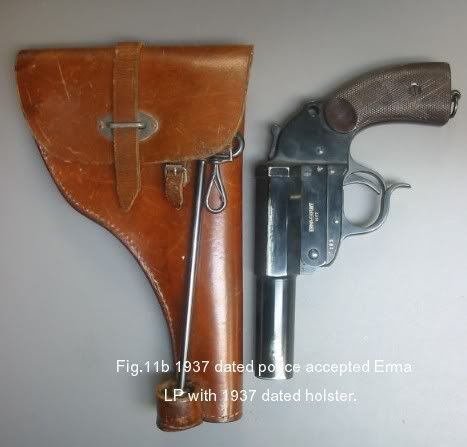
Production continued with almost 2000 units produced in 1938 (recorded serial range 1099-2989). Police Inspection Offices K and L participated in the acceptance of these weapons.
Later in 1938, the RFSSuChdDtPol (National Commander SS and Chief of the German Police) ordered the design and creation a holster for those gas pistols in inventory
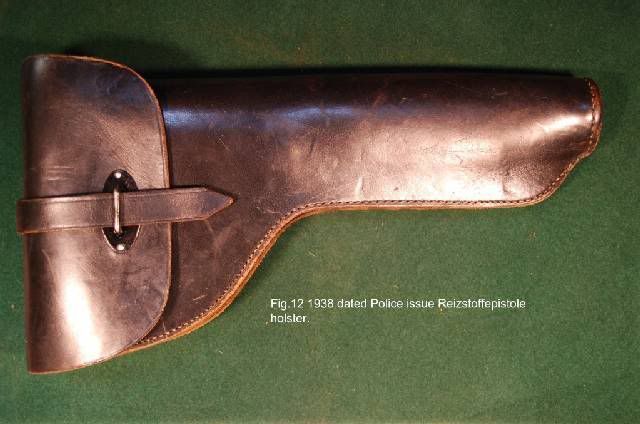
and calling in all remaining Leuchtpistolen a. Art for conversion to tear gas gun at the main arsenal in Berlin, to be accomplished no later than 31 January 1939. Some of these tear gas guns have been reported with markings of Police Acceptance Office C. The 1938 police budget supplement anticipated 300 more flare pistols for 1939 at an individual cost of RM60,00 for the pistol, holster and accessories. It is not known if any of this anticipated contract was fulfilled, as no 1939 dated Erma manufactured flare pistols with police acceptance marks have been reported. With the expansion in the use of SS-Police forces as occupation troops and for anti-partisan duty, Erma expanded production from 1940 to over a thousand a year through 1942.
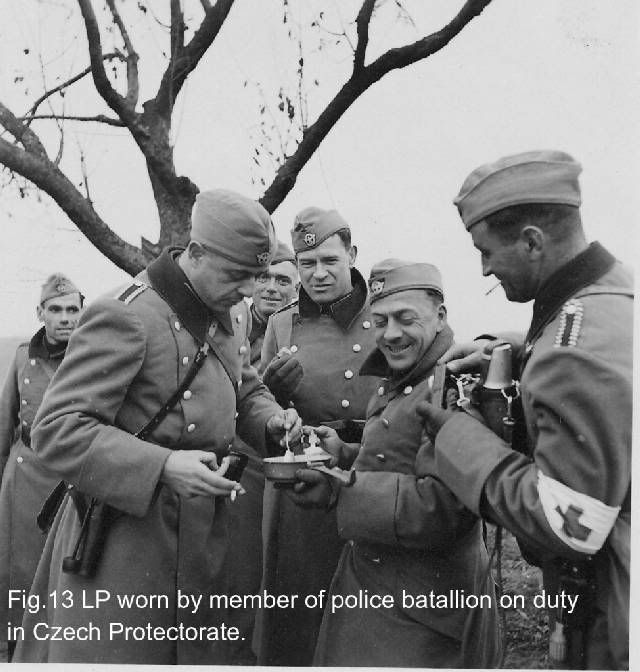
Cartridge boxes were issued in either black or brown.
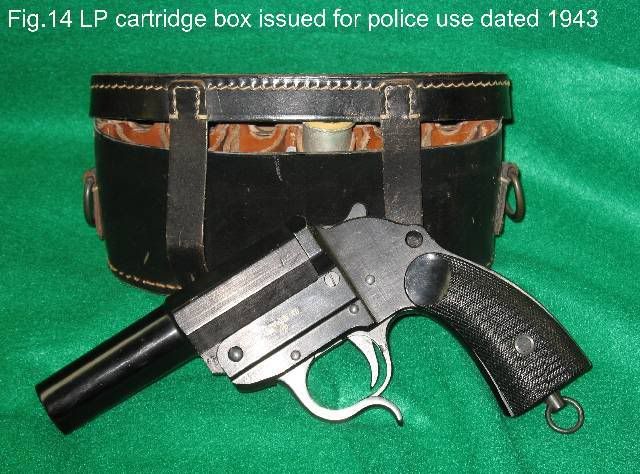
As the role of militarized police troops continued on all fronts, their use of the multi-purpose Walther design continued. Official police combat weapons and training manuals established two flare pistols to be issued for each Zug (platoon) with an issue of twenty each white and red shells and ten green ones, totaling six flare pistols per company, with two more to be issued for each of the three MG Zug (machine gun platoon). If the battalion contained a Berittene Zug (Mounted Platoon), then two more flare pistols were issued for that platoon. With the establishment at twenty four pistols per battalion excluding the mounted platoons and with over three hundred police battalions in the field until regimental formations appeared in1942, it would require an estimated 7200 flare pistols for combat use of the Schutzpolizei.
Shortly before the outbreak of WWII, Walther had instituted model modifications at the request of the Wehrmacht. Such changes as narrowed hammer, thinner grip plates, simplified lanyard ring pin and loaded indicator resulted in a design referred to by collectors as the Wartime Finish, as opposed to the original standard Heer finish. However, Erma Erfurt did not introduce these changes in their police contract until sometime between 1940 production weapon 4136 and 1942 production weapon 6342. 1942 was the last dated aluminum Erma production pistol, followed in serial sequence by zinc pistols which exhibit the Wartime Finish. So it would seem that zinc production began in late 1942 or in 1943.
Erma-Erfurt reported serial ranges:
1940 3106-5078 E/L,E/F and E/K
1941 5304-5904 E/K
1942 5977-6792 E/K and E/F
Zinc 7150-7898 E/F
While it appears that Erma-Erfurt provided the bulk of LPs used by German police forces before and during WWII, Waffenfabrik Walther continued production of their LP under police contract through the late 1930s and into the war. But the lack of reporting makes it difficult to establish dates and serial number ranges. E/K examples have been reported in the 27000L range as well as the 50000L through 56000L range, with the later examples being Zink frame production.
The Leuchtpistole neu Art was also issued to units of the Sicherheitspolizei (SIPO), except the Kriminalpolizei, and the Sicherheitsdienst (SD), along with black holster, metal cleaning rod/case ejector and wood cleaning stick. The replacement cost of this pistol was RM46.20. These units were of course involved in the Einsatzgruppen and anti-partisan warfare on both fronts. As the these units shared police weapon resources with the regular police, there is no question Erma-Erfurt police proofed flare pistols saw service with them.
Between 1941 and 1943, police units were schooled in the use of the W.Gr.Patrone, a grenade cartridge designed to be used with the Leuchtpistole. However, the addition of a shoulder stock fabricated of tubular metal affixed by claw mount behind the hammer was deemed necessary because of heavy recoil. The introduction of the Kampf Pistole (combat pistol) also known as the Z-Pistole found favor with police units which often found themselves in defensive positions. Extracts of police correspondence from the RFSS records at the U.S. National Archives indicate the supply of the Kampfpistole to SS-Police Regiments 2, 10, 11, and 13 on the eastern front in January 1944. Supplies for each pistol included both explosive and smoke rounds, as well as one cartridge case. The twenty-six Kampfpistolen issued to each company of certain battalions in the regiments were to be used for close combat and sudden enemy breakthroughs. Supplies came from the main arsenal in Berlin.
To date, no police accepted specimens have been reported. Undated, commercially marked ERMA-ERFURT "Z" pistols are noted in a serial range from 300 to 4289, but bear no police acceptance mark. The "Z" pistol did not enter general service until shortly before WWII, so it would seem that these "Z" pistols are of a different serial contract run than the regular police Leuchtpistolen. But, these commercial "Z" pistols exhibit the same "proof" mark on the left receiver as those with police acceptance marks, so perhaps police needs were satisfied with a direct commercial purchase without police acceptance.
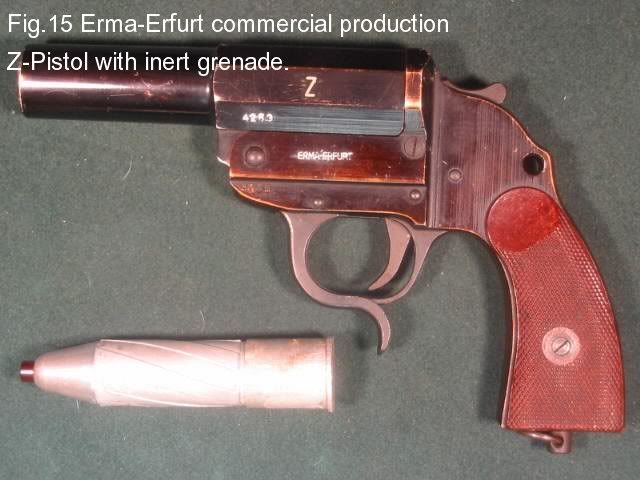
In the last years of the war, German police combat units made extensive use of foreign equipment. Units of the ORPO in the Italian and Balkan theaters received the Italian 27mm flare pistol and projectiles from police arsenals , while Water Police units in Russia employed the Czech Vz.30 flare pistol.
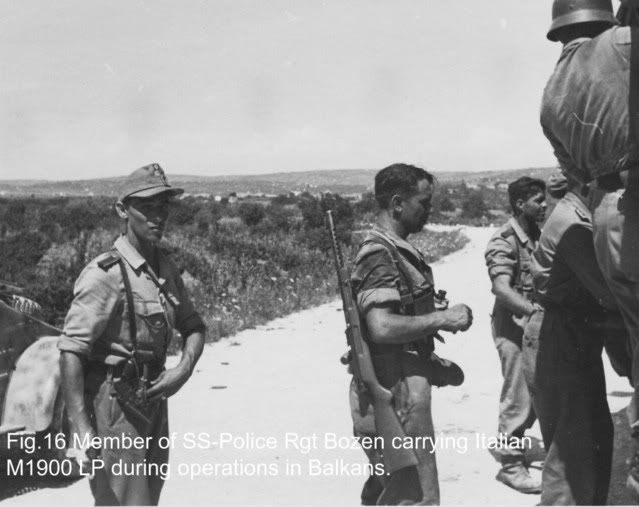
SOURCES
1. Runderlass der Preussen Ministerium des Innern, Berlin1923 &1925.
2. Runderlass der Reichs und Preussen Ministerium des Innern,Berlin,1936,1938, 1941.
3. Waffentechnisches Unterrichtsbuch f.d. Polizeibeamten, Schmitt, Berlin, 1929.
4. Vorschrift f.d. Polizei Preussens Nr.40a, Berlin, 1932.
5. Schutzpolizei im Kampfeinsatz, Wirth und Göhler, Berlin, 1942.
6. Waffen und Schiesstechnischer Leitfaden f.d. Ordnungspolizei,
Fischer, Berlin, 1941 & 1943.
7. Records of the Reichsführer SS und Chef der Deutschen Polizei,
T-175, Captured German Documents Collection, National Archives, Washington, DC.
8. Waffen-Digest
(c) Copyright by Joseph Wotka, USA

